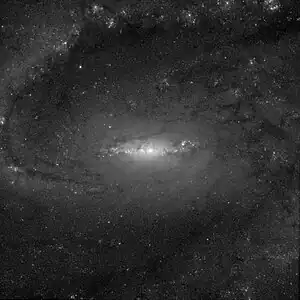| NGC 1255 | |
|---|---|
 NGC 1255 (NASA/ESA HST) | |
| Observation data (J2000.0 epoch) | |
| Constellation | Fornax |
| Right ascension | 03h 13m 32.04s [1] |
| Declination | −25° 43′ 30.60″ [1] |
| Redshift | 0.005624 [1] |
| Heliocentric radial velocity | 1686 ± 3 km/s [1] |
| Distance | 69 Mly[1] |
| Apparent magnitude (V) | 10.7 [2] |
| Apparent magnitude (B) | 11.5 [2] |
| Characteristics | |
| Type | SBbc [2] |
| Apparent size (V) | 4.2 x 2.6 [1] |
| Other designations | |
| PGC 12007, MCG -4-8-50, ESO 481-13 | |
NGC 1255 is a barred spiral galaxy approximately 69 million light-years away from Earth in the constellation of Fornax.[1]
Observational history

NGC 1255 was discovered by American astronomer Edward Emerson Barnard on August 30, 1883 with the 6-inch refractor at Vanderbilt University.[3][4] He described it as a "faint nebula, not large, pretty even in light. A faint star close p and slightly south probably involved. Star is s and f the nebula by about 30'".[3] American astronomer Ormond Stone made an independent discovery in 1886 with the 26" refractor at Leander McCormick Observatory, recording "4.1'x2.0', PA 315°".[3][4]
Supernovae
Supernova SN 1980O of magnitude 17.0 was detected in NGC 1255 on October 30, 1980.[5][6][1] It was discovered by German astronomer Hans-Emil Schuster with the 1.0-m Schmidt telescope.[5][6] The supernova was classified as type II, and it was located at the following coordinates: RA 03h 13m 27s, Dec -25° 44.50′ (J2000 epoch).[1] By December 30, 1980 the supernova had faded by about 4 magnitudes and showed strong P-Cyg-type profiles.[5]
A second supernova, SN 2022ame (type II, mag. 17.3), was discovered on 27 January, 2022.[7]
See also
References
- 1 2 3 4 5 6 7 8 9 "NASA/IPAC Extragalactic Database". ned.ipac.caltech.edu. Retrieved December 16, 2017.
- 1 2 3 "Revised NGC Data for NGC 1255". spider.seds.org. Retrieved December 16, 2017.
- 1 2 3 "Data for NGC 1255". www.astronomy-mall.com. Retrieved December 9, 2017.
- 1 2 "New General Catalog Objects: NGC 1500 - 1549". cseligman.com. Retrieved December 16, 2017.
- 1 2 3 "Central Bureau for Astronomical Telegrams". www.cbat.eps.harvard.edu. Retrieved December 9, 2017.
- 1 2 "List of Supernovae". www.cfa.harvard.edu. Retrieved December 9, 2017.
- ↑ Transient Name Server entry for SN 2022ame. Retrieved 24 March 2023.
External links
- NGC 1255 on WikiSky: DSS2, SDSS, GALEX, IRAS, Hydrogen α, X-Ray, Astrophoto, Sky Map, Articles and images